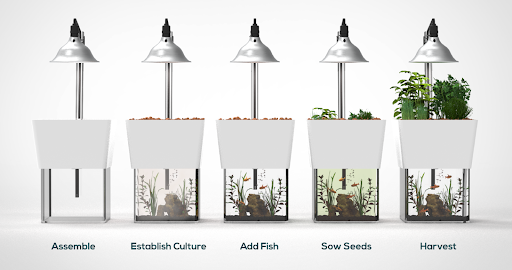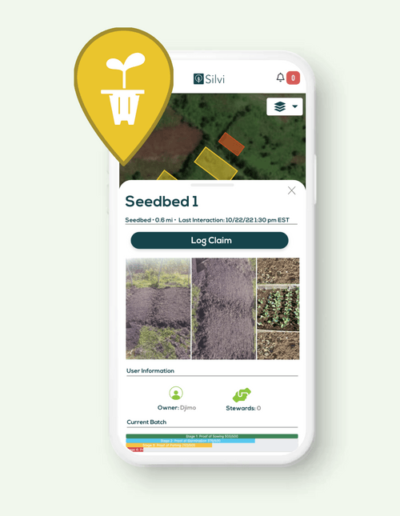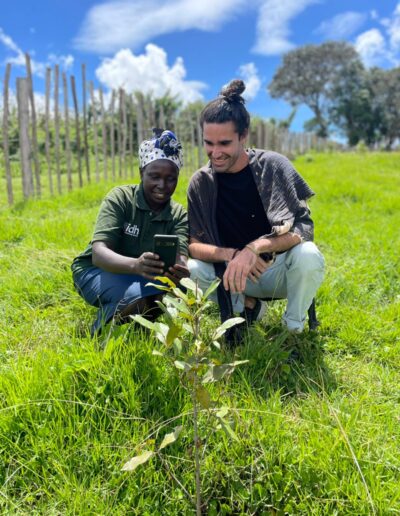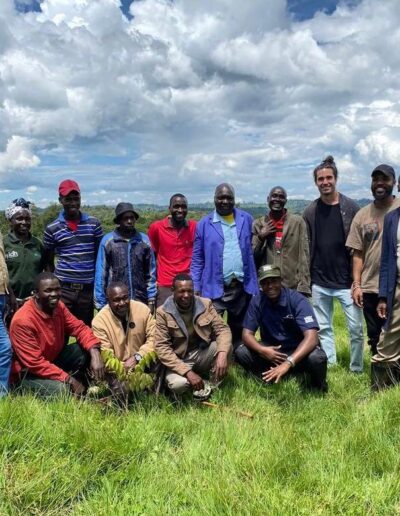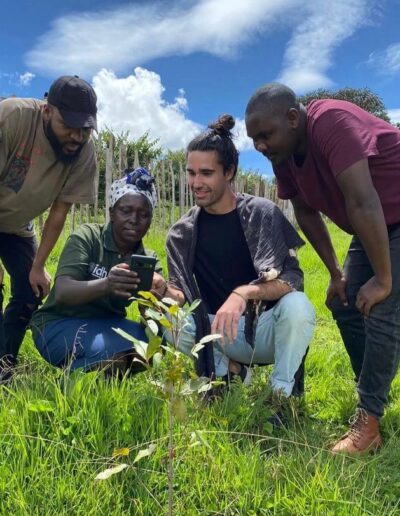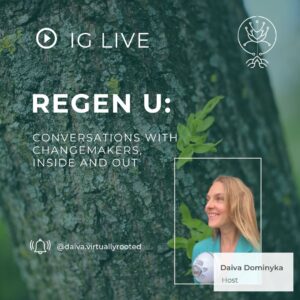🌳 Regen U: Meet Djimo Serodio, a solarpunk behind Silvi, an app that helps billions of people plant a trillion trees
Welcome to Regen U: Conversations with changemakers, inside and out. An interview series with impact-driven entrepreneurs that champion climate action, regeneration and recognise the imperative for individual and collective healing.
This time, I talk with Djimo Serodio, a solarpunk, nature-inspired technologist and the “tree man” behind Silvi—an app that helps billions of people plant a trillion trees. Whether you’re running a mid-large-scale reforestation project or an urban forestry initiative or want to share the progress of trees you plant in your backyard, the Silvi app will help you tell the story of the trees you plant.
Hi Djimo, thank you for agreeing to share your story with me. We met at a reforestation project in Sicily, where I got to test your app in real life. After that experience, I was curious to learn more about what you do, your story and see how we can support your work. I always start by asking:
What is regeneration for you?
Regeneration is the conscious intervention that society has as a species to reverse our negative impacts on ourselves and our planet.
Some people understand regeneration almost like a permaculture mindset. However, there are more economic angles to this, like circular economics. My preferred space within regeneration is one of regenerating our natural ecosystems, creating natural capital and contributing positively to biodiversity and ecology. There are many interpretations of regeneration. There’s also inner regeneration, which I’m no expert on, but I think without inner regeneration, it’s hard to regenerate the outside world.
You describe yourself as a solo punk, a nature-inspired technologist, and a ”tree man” behind Silvi. How did these definitions come about?
I am deeply inspired by nature, but I’m also very passionate about technology, and these things often contradict each other. Many people don’t fit in the middle and prefer to lose technology completely and disconnect from it. But I don’t necessarily associate myself with that.
I do see a future where we can develop and embrace technology to use it for the greater good, leveraging technology to restore nature’s qualities.
Have you always been entrepreneurial?
Back in middle school, I was already entrepreneurial. I remember one of my more successful early entrepreneurial journeys: I filled out my backpack with Chiclets, these bubble gums. I’m talking about $200 worth of bubble gum. And I would walk around the school, and people would buy them. It’s just cash in, bubblegum out.
After just over a year of doing this, I was able to buy a $7,000 motocross bike, which was my first bike. I saw firsthand that a business can actually generate money. It inspired me to pursue entrepreneurialism. For what it’s worth, my college in the US was in entrepreneurship, but did I actually learn a lot from school? Probably not. And I do focus on certain subject matters that I definitely didn’t learn in school, like agriculture, environmental science and ecology.
Could you share the journey that led to the creation of your regeneration platform, and were you always conscious of the climate crisis as a driving force?
In my teens, I was already very much in tune with the problem. Before Silvi, I started my career in many facets of agriculture and was inspired by what aquaponics taught me. Aquaponics combines aquaculture and hydroponics, growing plants without soil just on water. Aquaculture is the rearing of fish in a recirculating water system. But when you combine both of them, you get aquaponics. In my eyes, it was an incredible example of what a sustainable closed-loop system is, which is kind of how our planet also is.
And so I developed a tool for education called PlanetBox, an aquaponic system. And this came with curriculum and with some software and it’s called JustLearn. I grew this to over 40,000 students, and we deployed Aquaponic systems in over a thousand classrooms, mostly in the southeast US area, Florida, primarily some Northeast as well, like Boston.
At a certain point, we wanted to expand beyond indoor activities, which the Aquaponic system served more into outdoor activities. And that’s how we started looking at reforestation as a module to offer curriculum. We were already doing things like learning how to compost and understanding pollination better and even some renewable energy activities. But we were looking at offering reforestation, and what originally was just a module of Just Learn has since spun off into Silvi, an entire reforestation protocol.
You started by asking an excellent question, “How do we enable 100 million people to make a living planting 1 trillion trees?” How did you arrive at this question? Why find a way to pay for planting, and why 100 million people?
We had about 6 trillion trees at the beginning of time, and our species has contributed to the loss of half of them. (There’s a famous lab in ETH Zurich called the Crowder Lab. This is the epicentre of forestry research, and they’ve written many articles that quantify the cumulative tree loss).
Now, there is reasonable room to recover about 1 trillion trees. This is globally known as the trillion tree movement that is being embraced by various levels of government, private sector targets and commitments, etc. Namely, the World Economic Forum has created 1T organization. Silvi’s mission is to support this movement and help make this vision a reality. With something so distributed and diverse as trees (there are 70,000 tree species around the world with many nuanced approaches to stewardship.
I do fundamentally think that this should be the work of a billion people. It could be something that we all as a society should undertake and participate even if in a small amount.
And to reach as many people as possible, do you collaborate with other organizations undertaking the same mission, or do you feel quite alone in the field?
We’ve been supported by 10 grants. So I’m super grateful for the fact that Silvi has so far been built without traditional investments and with the help of, in some cases, more philanthropic. In other cases, it’s more ecosystem grants, but there are a subset of technologies out there that believe in what we’re doing and see it as a use case for adopting their tech.
A lot of these technologies are in blockchain, and a lot of this tree data is meant to be transparent, accountable, and on-chain. So it’s a perfect mix for us. So I wouldn’t say that we feel lonely. We definitely have a lot of collaborators.
The industry as a whole feels a little bit slow and less urgent, but that’s not the fault of those who are already collaborating with us. We’re very grateful for that. Perhaps there could be more appetite for, and more nuanced understanding of what real regeneration of land restoration is when the right trees are being planted in the right locations, and ecology is being engineered in the right way. And so, I think we should also make it our mission to communicate this problem-solution matrix. So we will continue doing that.
In 2022, Silvi’s network of early adopters propagated ~70,000 trees across 15 pilot sites in Kenya around the Kakamega Forest – what an incredible impact! Can you tell us more about this project?
Kagamega forest is the last remaining tropical rainforest in East Africa. Due to human settlement and agriculture, that rainforest has been isolated in a small pocket of about a hundred square kilometers. It has incredibly rare species and fauna that are at risk of extinction.
We are delivering our theory of change by engaging communities on the outskirts of the forest, which are primarily smallholder farmers, to participate in reforestation using our tools, methodologies, and regenerative approaches.
In simple terms, it means that the smallholder farmers, in a hyperlocal way within one square kilometre are identifying mother trees, collecting seeds or seedlings or cuttings. Then, they take them home or to a community nursery. They propagate these seedlings on a large scale, usually at least 2000 seedlings per farmer.
They go through our methodologies, through our tech, we do onboarding and capacity building, and we pay them for this type of conservation and stewardship work.
Ultimately, we’re building an inventory of trees across multiple communities that can go back into the forest. Now, planting needs to be a little bit more planned out because you need to do it during the rainy season.
Farmers live by the forest, and we can easily identify parts of the forest that need planting and register and monitor those plantings. This creates an opportunity that adds value to the reforestation supply chain.
We are now working towards 20 new pilot sites around the world via Operation WebTree. But Kenya remains our biggest project.
How do you work with local communities? Do you have any set of principles for community integration?
INGING wouldn’t say that we’re mature. We have a mature playbook on how to do things but we’re still very much learning.
How can we make technology less colonial and invasive and more empowering, enabling indigenous communities to take the lead and ownership in restoration?
We hope to make that connection.
Indigenous communities are very experienced and, in some cases, the only ones that actually know how to work with some species. So, this idea of indigenous wisdom or indigenous knowledge is extremely important, and it might be a very beautiful use of technology.
We now work sort of 50-50 amongst both gender groups and often, women outperform men in terms of level of trustworthiness and loyalty to the program and accountability and communication, etc.
Further, we now work sort of 50-50 amongst both gender groups, and often, women outperform men in terms of level of trustworthiness and loyalty to the program, accountability, communication, etc.
Also, within these impact zones, we’re not just focusing on farmers. We’re also interested in schools. I think the pedagogy can still benefit tremendously from being contextualized and applied to stewarding the local habitats of those people. So yeah, we’ve now deployed the program in about a dozen schools as well, and we hope to continue scaling these efforts.
Does Silvi support any particular practices of tree planting and regeneration?
So we’re on a mission to help with the trillion trees, but not all of those trillion trees necessarily need to be indigenous native trees, planting and protected forest zones. A lot can be done to make agriculture less invasive, less destructive and less exploitive.
One of the big practices within the agriculture field is agroforestry and its variations. We’re collaborating with folks who are building methodologies around agroforestry, but we’re not so much taking a lead in being experts. We’re still focused on creating the data layer that can empower these other tools and the MRV data, the monitoring, reporting and verification ability.
Regenerative finance can be a complex world. Does this complexity sometimes stand in the way, and how do you translate the concept to an elderly farmer who might not be familiar with Refi, let alone an iPhone?
Yeah, that’s an interesting question because there are two approaches to it. On one hand, ReFi (Regenerative Economics + Decentralized Finance) has created a little movement, a headspace where we’re in this to save the planet, create public goods, and all this. And I think that’s a really important wave to surf and build momentum on.
But ultimately, although we are agnostic of the technology, I admit that blockchain brings a lot of qualities. I think the simplest understanding is that now we can program money to a financial mechanism to a particular logic or a set of events or code, what we know as smart contracts.
Now, if you don’t understand it, it might be hard to grasp what’s going on, but in the normal world, we have money as a tool. Then we have legal contracts as a complimentary tool, and then we have regulatory frameworks as a playground, and we need to align all these things together. And I think blockchain helps integrate more seamlessly and more easily in a mechanism that includes the money, but also includes predefined outcomes or conditions that need to be met for the money to behave in a certain way. And I think that makes for a great toolkit from which you can design methodologies and eco credits and reforestation as a sort of plant-to-earn model.
I am coming from advocacy to an entrepreneurial space and I’m interested to see how brands act in terms of their communications and their political involvement.
Does Silvi engage in a broader political action?
I am facing real dilemmas, perhaps less about how we develop our brand and more about what type of brands we associate with.
It’s no mystery that the fossil industry has been a primary source of emissions. Our CO2 surplus in the atmosphere primarily comes from the energy sector, most of which of has been fossil fuel-based. And along with all of that, there’s a lot of greenwashing.
That being said, and I’m going to use an example, Shell (they certainly are involved in sketchy schemes of carbon credit trading and offsetting and carbon neutral fuel, etc.), but I see that, and I’m not repelled as much by that.
Some people do a U-turn, and they don’t want to associate themselves with companies like Shell, as an example, and I see this as a reminder that we actually have to develop tools that do work, and we have to maybe help these brands fix themselves.
And we might even have to empower them to lead the change because Shell, has billions of dollars in profitability and a responsibility to offset. It’s an extremely mature company and it’s so empowered to lead the transition and to invest in future asset classes and energy sources and high-fidelity carbon credits or lead ecological restoration. And so, why will we shut them off and operate in this conflict instead of trying to harmonize and work together?
When people think about regeneration, they think of Peter living in some field somewhere growing vegetables and flowers, and that’s awesome. But we need to involve the big players and the ones that perhaps have received scrutiny over their actions.
We need to hold hands with them. Again, they’re huge organizations of individuals, many of whom are not responsible for the past actions of those organizations. So I’m trying to figure that one out, I suppose.
How can we support Silvi in 2024? What’s on the horizon for you guys?
We’re now in open beta but anybody can use it.
If you’ve ever planted a tree, or you have a friend who planted a tree or has done community tree planting, please go register those trees.
These are living memories of a particular action that I think is exemplary and that is helping put together data that will be the foundation of what many people call natural capital.
And so things like not to be nerdy and technical, but the timestamps, the location, the species, your contribution to that is all super important.
Now we’re trying to build a more mature version of this platform, and it’ll take some time, but effectively, you’re helping be an early adopter. If you have feedback on the app, we’d appreciate it.
It not only brings visibility to your particular tree planting or reforestation work, but it could help others in the area contextualize their contributions because they can see yours, they can know where your tree is and come verify it and confirm that it’s still alive.
We’re trying to build a community-driven reforestation-focused technology. So yeah, if you’ve ever planted a tree or intend to plant one, check out Silvi.earth, and you can register and sign up; it’s free!
And if you’re working on real reforestation, reach out because we might have a micro-grant for you, and we might be able to pay you for some of this work.
Thank you so much, Djimo!
Enjoyed the conversation?
Subscribe to Regen U: Conversations with changemakers, inside and out. ⬇
REGEN U: CONVERSATIONS WITH CHANGEMAKERS, INSIDE AND OUT
Stay in the loop to meet more regenerators
Monthly live interview series and newsletters with impact-driven businesses



